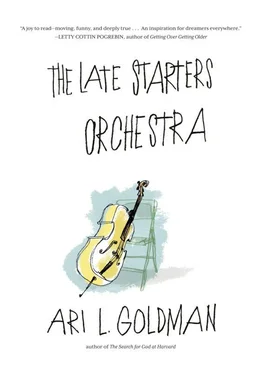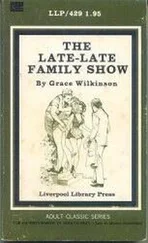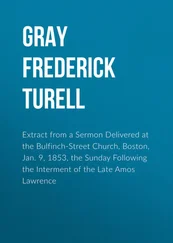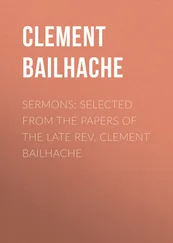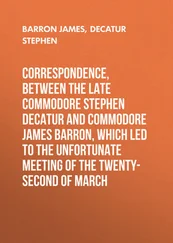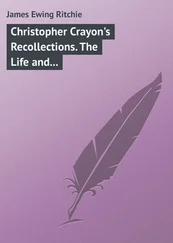And then Elena raised the same question I have been struggling with ever since my first day with LSO: “At what point,” she wondered, “do you get to call yourself a ‘musician’ and not feel like an impostor?”
I know what she means. After one LSO rehearsal, I walked under the marquees of a half dozen Broadway theaters and hopped on the Fiftieth Street crosstown bus. A young woman saw me coming down the aisle with my cello on my back and offered me her seat. I thanked her but explained that it is easier to stand than to take the cello on and off my back in order to sit. “But you must be tired,” she insisted. “It’s hard playing a matinee. And you have to go back in a few hours to play the evening performance. Right? ”
I smiled knowingly and said bravely, “It’s okay, I’m used to this.”
When we meet for rehearsals, Magda has no time for small talk. She spreads her score out on two music stands and keeps her violin on a small table nearby in case she needs to demonstrate something musically. Right after we tune, we play.
Being in tune is essential. An out-of-tune instrument offends the ear, especially a sensitive ear like Magda’s. It doesn’t take much for a string instrument to slip out of tune (a change in temperature, a bumpy bus ride, a chance encounter in the elevator); that’s why musicians are always tuning.
I usually managed to arrive at LSO on time, but one Sunday there was emergency subway track work on the Number 1 train and it took me forever to make it downtown. The orchestra was already playing. I found an empty chair, set up my music stand, took out my cello, and looked over the shoulder of another cellist to see what we were up to. I found the spot in the music and fell in line with the rhythm. At one point, we cellists had to shift to the open C string and that’s when I heard it: my C was woefully out of tune. That long commute had apparently taken its toll.
I wanted to sing out, as Mr. J had taught me, but I wondered if I could do it by ear alone, like the pros do. Get the sound in your head, Mr. J said. Sing, but silently this time. I reached for the fine tuner — that little knob below the bridge — but I realized that we were talking about major surgery here, not fine-tuning. I lifted my right hand to the top of the cello, known as the scroll, and gave one of the pegs a sharp twist as I plucked the string. Bingo! My C was back in tune. I felt like a pro! Beaming, I joined my fellow musicians.
The next piece was by Carl Nielsen, an early twentieth-century composer. We started together, but then Magda singled out the cellists for special attention. “It starts with an E,” she said. “I am hearing an A. Who is playing an A?”
My heart sank. I was busted, exposed for being the musical fraud that I was. But just then, a woman in the front of the cello section fessed up. “It was me. I’m sorry, my strings keep slipping. Must be the weather.” I breathed a silent sigh of relief. But just to be sure, I double-checked my note and sang along to be sure. It was an E, after all. I had tuned right and stayed in tune.
Magda, of course, worried about notes, but even more than the notes, she cared about rhythms. In one piece by Edvard Grieg we were having a particularly rough time. She told the violins to put down their instruments and clap out the rhythms while the cello section kept playing the base line. “Again,” she said. “And again.” She had us do this exercise six times. “That’s better,” she finally acknowledged.
“Always start with the rhythm, even if you get the notes wrong. Skip the notes, if you must, but keep to the beat.” Magda constantly emphasized the importance of listening as well as playing . “Cellos,” she said, addressing us, “you have to listen to the violins. Otherwise you run off on your own.”
Magda is extremely orderly and precise, but sometimes she surprises us. In the middle of one rehearsal — a rehearsal that wasn’t going well — she told everyone to stop, put down our instruments, and stand up. “We are going to rearrange the room,” she announced. She made me think of a fifth-grade teacher who was fed up with the class’s lack of decorum. If things don’t work, shuffle the deck.
Instead of facing her, Magda wanted us to face in different directions at sharp angles to one another. “The only requirement is that no one faces me.” Chairs and music stands were soon scattered around the room. “Now find a place, sit down, and play.” No one could quite figure out what she was up to. All this was so un-Magdalike.
“The goal,” she said, “is not to look at me but to listen to each other. Now play.”
It is tough playing without seeing the conductor, but we did, guided by the music rather than our leader. It was disorienting, but a valuable lesson.
After a few more tries at it this way, she grouped us once again by instruments and we faced her. We tried it again. “We are getting there,” Magda said. “Of course you must watch me, but most of all you must listen to each other.”
Before a performance, Magda was especially inspiring. “Be confident,” she told us. “You should have no doubts. Believe in yourself.”
You rehearsed it and you know it well. Confidence!
Sometimes her words mingled in my mind with those of Mr. J. There were times I couldn’t tell them apart.
Do not be timid. Just play. Express yourself. Think about the sound, the music, the colors. Don’t worry that you will miss a fingering or a bow direction. If you skip a note, no one will know. It is about the character of the music.
“Be confident. And look confident,” Magda said. “Articulate each note. Good actors in the theater don’t mumble. They articulate each word. Articulate.”
And even if you don’t feel confident,” she said, “look confident.”
If you look frightened, the audience will only feel bad for you, Mr. J agreed.
“Now give them something they will remember,” Magda added.
There was one performance where, despite the pep talks, the first violins were not convinced. In the hour before the performance, when we were having our final rehearsal, Magda demonstrated a particularly difficult passage in a Vivaldi piece, the “Spring” movement from The Four Seasons. She played it once with the first violins and then with the whole orchestra. “Now, play it yourselves,” she instructed. But the first violins went awry.
“I think we need you at the concert,” said a violist named Ron.
“People aren’t coming to hear me, they’re coming to hear you,” Magda said. “You are on your own.”
But when we got to the Vivaldi at the performance, Magda took pity on us. She pivoted to the side so that she half faced the audience and half faced us and she played the Vivaldi while conducting with her head and eyes. She was magnificent.
And we sounded pretty good, too.
The LSO members I played with came from all different backgrounds. While Elena was a true late starter, coming to the violin after college, Andrea was a returning late starter, someone who read music and played an instrument as a youngster, gave it up for years, and then came back to it later in life. Perhaps Nishanti, a woman in her thirties, had the most enchanting story.
Nishanti was born in Sri Lanka and moved to the United States when her father, an emergency room physician, found work in rural Pennsylvania. Nishanti took piano lessons as a child and picked up the violin in elementary school and played through high school. But, she told me, she associated the violin “with being a kid” and left it home when she went off to college. Hers was a long route through college with time off to waitress, it seemed, “in every coffee shop in Pittsburgh.” She graduated college in her late twenties and made her way to New York, and eventually found work in financial operations on Wall Street, where she developed a specialty in derivatives. When I commented that it must have been exciting work, she said, “I didn’t particularly enjoy my job. In fact, I hated it. It got to the point where I was crying at my desk every day.”
Читать дальше
